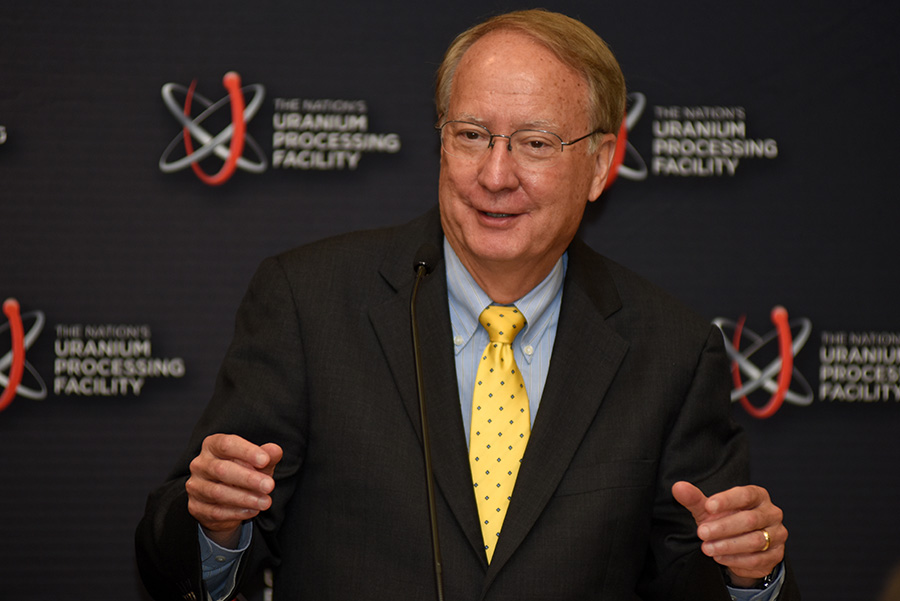“We continue to count on the valuable contributions of the Arms Control Association.”
Nuclear Warhead Costs Rise
December 2018
By Kingston Reif
The estimated cost of the Energy Department’s plans to sustain U.S. nuclear warheads and their supporting infrastructure has risen sharply over the past year, adding to concerns about affordability.
 The department’s semi-autonomous National Nuclear Security Administration (NNSA) on Nov. 1 released the sixth version of its annual report on the Stockpile Stewardship and Management Plan. The fiscal year 2019 iteration projects more than $390 billion in spending on agency efforts related to sustaining and modernizing the nuclear weapons stockpile over the next 25 years. This is an increase of $70 billion, or 22 percent, from the 2018 version of the plan.
The department’s semi-autonomous National Nuclear Security Administration (NNSA) on Nov. 1 released the sixth version of its annual report on the Stockpile Stewardship and Management Plan. The fiscal year 2019 iteration projects more than $390 billion in spending on agency efforts related to sustaining and modernizing the nuclear weapons stockpile over the next 25 years. This is an increase of $70 billion, or 22 percent, from the 2018 version of the plan.
The new NNSA plan begins to reflect the recommendations of the 2018 Nuclear Posture Review (NPR) report released in February, which called for developing two additional low-yield nuclear capabilities, retaining the B83-1 nuclear gravity bomb, and expanding the NNSA’s plutonium-pit production capacity. (See ACT, March 2018.) These initiatives are part of a proposed expansion of NNSA nuclear weapons work that the report says would provide “capabilities needed to quickly produce new or additional weapons” beyond the 3,800 warheads currently in the active U.S. nuclear stockpile.
The NNSA states that the projected growth in spending “is generally affordable and executable” due in part to large funding increases provided to the agency by Congress over the past two years. But according to a U.S. Government Accountability Office (GAO) report published in April 2017, the NNSA’s plans to modernize its nuclear weapons “do not align with its budget, raising affordability concerns.”
Like the GAO, former NNSA Administrator Frank Klotz raised concern about the level of demands on the NNSA in coming years envisioned by the Trump administration. “The agency is “working pretty much at full capacity, and you can draw your conclusion from that,” he said in an interview with Defense News two days after leaving office in January and before the release of the NPR report.
The Democratic takeover of the House of Representatives as a result of the November midterm elections is likely to bring greater scrutiny of the administration’s efforts to upgrade the nuclear arsenal. (See ACT, November 2018.) Rep. Adam Smith (D-Wash.), the ranking member on the House Armed Services Committee who is poised to become chairman in January, told Arms Control Today in a Nov. 16 interview that the current Energy and Defense Department plans are “certainly unsustainable from a fiscal standpoint.”
The largest source of projected growth in the new stockpile plan is in the area of nuclear and non-nuclear production facility modernization, including new plutonium-pit production, uranium processing, and uranium-enrichment facilities. Whereas last year the agency projected $8.6 billion to $39.3 billion in spending, including the effects of inflation, on these and other facilities, it now estimates the cost at $61.1 billion to $90.7 billion.
The NNSA plan also foresees an increase in spending relative to the 2018 version on warhead life extensions programs through the beginning of the 2020s even as it follows the NPR report in backing away from a controversial proposal to develop three interoperable warheads for deployment on land- and sea-based ballistic missiles as part of the so-called 3+2 strategy.
Since 2013, the NNSA had planned to jointly replace the W78 intercontinental ballistic missile (ICBM) warhead and the W88 submarine-launched ballistic missile (SLBM) warhead with a new interoperable warhead known as IW-1. Two subsequent interoperable warheads were slated to replace the W87 and W76 warheads.
Instead, the NPR report called for accelerating replacement of the W78 by one year to support deployment on the Air Force’s new ICBM by 2030 “and investigate the feasibility of fielding the nuclear explosive package in a Navy flight vehicle.” The report did not commit developing additional common warheads.
But the uncertain future of interoperable warheads does not appear to have reduced the projected cost of replacing the W78, which is projected to cost $12.5 billion, an increase of $500 million above last year’s estimate. The stockpile plan states that the warhead will consist of “all newly manufactured components” and “new technologies.”
Congress repeatedly questioned the wisdom of the prior plan to buy interoperable warheads, citing the cost and risks involved with the plan. In a March 2017 letter to the GAO director, Reps. Smith and Marcy Kaptur (D-Ohio), the likely next chairwoman of the energy and water appropriations subcommittee, expressed “concerns about the affordability of the IW-1.”
The fiscal year 2019 energy and water appropriations bill, signed by President Donald Trump in September, called on the NNSA to produce a report estimating the cost of a possible, less expensive alternative to the current plan to replace the W78.
The stockpile plan notably does not include any projected costs associated with developing a sea-launched cruise missile warhead and potentially extending the life of the B83-1 as proposed in the NPR report. Work on the cruise missile warhead is slated to begin in fiscal year 2020 and, according to the NNSA, “will be a major new addition in the next decade.”
